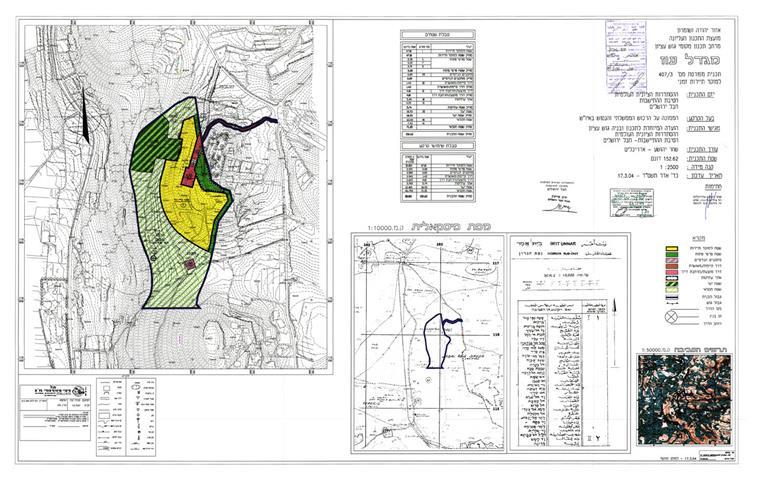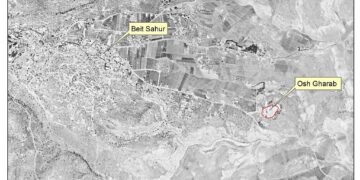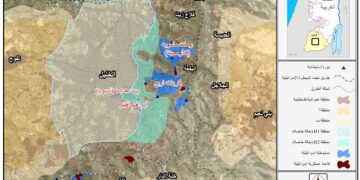On the 22nd of May 2015, the Israeli daily newspaper, Haaretz, revealed on its website that a new real estate deal has been settled and targeted the abandoned Beit al–Baraka building and hospital located on Jerusalem-Hebron road, to the north of Al-Aroub refugee camp and Beit Fajar town in Hebron Governorate. Several names emerged in this deal including Arieh King, director and founder of the Israel Land Fund (ILF) and member of the municipal council in Jerusalem municipality, a man who supports settlement projects in the occupied Palestinian territory and most specifically in and around Jerusalem city, as well as the right-wing Gush Emmunim settler movement, and Davidi Perel, the mayor of the Gush Etzion settlement bloc. In the meantime, works on restoring and rehabilitating the building is ongoing in an effort to turn it into an outpost and settle settlers.
The essence of the case study does not address the way in which the purchase deal and seizure of the property was settled because Israel has a long history of taking over property and land in the occupied Palestinian territory illegally. However, this case study is about to shed the light on the Israeli plans in the western part of Bethlehem Governorate including the newly seized property of Bayt Al Baraka and the Israeli efforts towards Judaizing the area and annexing it to its proper under what it calls “the Greaten Jerusalem”, which employs the annexation of the three major settlement blocs that surround Jerusalem city to Israel.
The western part of Bethlehem Governorate, known to the Israelis as the “Gush Etzion Settlement Bloc”, is the heart of Colonization in Bethlehem and Hebron Governorates. The bloc includes 11 Israeli settlements and spans over an area of 69.8 km². The bloc has a total population of more than 60,000 Israeli settlers, 44% of the total Israeli settlers population in the Bethlehem Governorate and 8.3% of the total Israeli settlers population in the occupied West Bank. The bloc is one of largest settlement blocs surrounding the city of Jerusalem along with Ma’ale Adumim settlement bloc in east Jerusalem (72.5 km², pop +50,000 ) and the Giv’at Zeev settlement bloc northwest of Jerusalem city (12 km², pop +16,000).
Israel is intensifying settlement construction within the Gush Etzion settlement bloc with the aim of imposing realities on the ground before reaching an agreement with the Palestinians, to ensure its annexation of the areas it still controls, referring to Area “C”, which according to Oslo II Interim agreement of 1995, the area “C”, Israel retains full control over land, security, people, and natural resources. Below are some key figures of Israel’s plans in the western part of Bethlehem Governorate:-
— To the northwest of Bayt Al Baraka building is the Israeli Civil Administration which is the coordinator of the Israeli Government Activities in the southern part of the West Bank (mainly Bethlehem and Hebron Governorates) and body responsible for the implementation of the Israeli government policies in areas that are still under the control of the Israeli Government, such as Area “C”.
— In early August of 2014, and after two months of kidnapping and killing three Israeli settlers in Hebron south of the West Bank, the women in Green movement led by its co-founder "Nadia Matar" announced the establishment of a new outpost near the Gush Etzion roundabout with the explicit support of the Gush Etzion settlement council, and was given the name "Oz Veaga’on". The site of the new outpost is quite strategic as it overlooks the surrounding Israeli settlements such as the settlements of Efrata and Migdal Oz in the southeast and the settlements of Alon Shvut and Kfar Etzion northwest. Additionally, the targeted area is a mix of forest and open area which allows settlement expansion in the future.
— Furthermore, to the east of Bayt Al Baraka building site, is the Israeli settlement of "Migdal Oz," which was established in 1977 on Palestinian owned land of Beit Ummar, Beit Fajar and Al Khader communities. The settlement today occupies a total land area of 1211 dunums and houses a total population of nearly 900 Israeli settlers. It should be noted that the area, which comes between the Israeli settlement of Migdal Oz and Bayt Al Baraka building and borders the Israeli bypass road number 60 from its eastern side, is targeted with new Israeli building plan. The plan holds No. 407/3 and aims to confiscate 152.6 dunums of Palestinian owned land in the area, to set up a "tourist attraction" site (settlement). See Map 1

Map 1: Israeli settlement plans near Bayt Al Baraka building
In addition to the aforestated, Israel issued several military orders during the year 2014 to confiscate more Palestinian land under the pretext of "state land", the most prominent was (I) In April 2014, when the “Custodian of Absentee property & Israel Land Authority of Judea and Samaria ” attached to the Israeli Ministry of Defense/Civil Administration, Yousi Sigal, issued a military order to seize 984 dunums of land from Bethlehem and Hebron Governorates, mainly in Al Khader, Nahhalin and Beit Ummer, by declaring it “State Land”. See Map 2
Map 2: a military order to seize 984 dunums of land from Bethlehem and Hebron Governorates
(II) and later on the 25th of August, 2014, the Israeli Civil Administration declared the seizure of 3799 dunums of land in Bethlehem and Hebron Governorate by declaring them “State Land”. The military order was issued by the so-called “The Custodian of Absentee property & Israel Land Authority of Judea and Samaria ” attached to the Israeli Ministry of Defense/Civil Administration , Yousi Sigal and targeted the land of Wadi Fukin, Husan, Nahalin, Surif and Jab’a villages. See Map 3
Map 1: Absentee Property – Judea and Samaria- 59/1967
To conclude,
The Israeli settlements in the occupied Palestinian Territory are one of the foremost obstacles to ever achieving any real progress in the peace process. Furthermore, they block agreement on the other important final status issues of Jerusalem, borders, water, refugees and Israeli security concerns. As more Palestinian land is taken for settlement expansion, less land is available for future Palestinian development. Additionally, as settlement building and expansion continues, there is growing concern that the increasing fragmentation of the West Bank territory will endanger the possibility of a contiguous Palestinian state in the future and this clearly contradicts various International Laws and Conventions, some of which are listed below:-
- The Fourth Geneva Convention of 1949, Article 49, and paragraph 6 of which states: 'The occupying power shall not deport or transfer parts of its own population into the territories it occupies.' Article 53 of the Convention also prohibits 'any destruction by the Occupying Power of real or personal property belonging individually or collectively to private persons, or to the State, or to other public authorities, or to social or cooperative organizations, is prohibited, except where such destruction is rendered absolutely necessary by military operations.'
- The Hague Regulations of 1907, Article 23 of which prohibits the destruction or seizure of occupied property, unless it is imperatively demanded by military necessity.
- United Nations Security Council Resolution 242 (1967) which requires Israeli armed forces to withdraw from 'the territories occupied' in the 1967 war, including the West Bank and Gaza Strip.
- United Nations Security Council Resolution 452 (1979) which calls upon 'the Government and people of Israel to cease, on an urgent basis, the establishment, construction and planning of settlements in the Arab territories occupied since 1967, including Jerusalem.'
- United Nations Security Council Resolution 465 (1980) which 'Determines that all measures taken by Israel to change the physical character, demographic composition, institutional structure of status of the Palestinian and other Arab territories occupied since 1967, including Jerusalem, or any part thereof, have no legal validity and that Israel's policy and practices of setting parts of its population and new Immigrants in those territories constitute a flagrant violation of the fourth Geneva convention relative to the protection of civilian persons in time of war and also constitute a serious obstruction to achieving a comprehensive, just and lasting peace in the Middle East.'
Prepared by
The Applied Research Institute – Jerusalem















